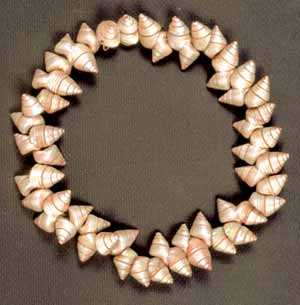 |
 |
|
Shell Necklaces
Palawa (Tasmanian Aboriginal) society has maintained a traditional cultural activity dating back at least 1800 years that has adapted and changed over time and across space. Palawa people celebrate their survival through the continuity of these cultural practices and beliefs. They are a proud, unique people with a rich, diverse cultural heritage. It is important to acknowledge the Aboriginal women who continue the ancient tradition of collecting, processing and stringing shells into delicate and intricate patterns, handed down through many generations from mother, Auntie, sister and daughter. The oldest known shell necklet was found in a coastal living place at West Point, south of Marrawah. The necklet, comprising 32 king or queen maireener shells each pierced with a small hole, had been placed with cremated human remains in a burial pit about 1800 years old. Making shell necklaces has always been the role of women, and today women stringers still have 'ownership' of the cultural tradition. Women had and have the knowledge of where and when to collect the shells, in places such as Bruny Island, Robbins Island, the coastline around Woolnorth, the north-east coast and on beaches around Bass Strait islands, usually between June and March. Strings of shells were of great value, used as items of trade or to enable collection of the sacred red ochre used in rituals. The collection and distribution of ochre was also the role of women. In 1792 Labillardière observed that Aboriginal women wore 'fillets of bright flowers, berries and strings of brilliant pearly blue spiral shells upon their bare heads', and he was given a necklet of pearly shells by an Aboriginal man he believed to be an important leader. Watercolours from Baudin's 1802 expedition depicted Baraourou, a man of Maria Island, wearing a circlet of king or queen maireener shells around his neck. These necklets are similar to that found at West Point. Records show three types of shell necklets worn by the Aboriginal people before the invasion: a circlet or crown worn around the head, a string worn close around the neck, and a band worn around the arm. There are differences in shell necklaces made thirty years after the invasion. The shells are smaller, and the necklaces are longer, worn in loops around the neck as they are today. The shells are maireeners but of different species; the 1802 necklet was made with king or queen maireeners, the 1830s necklace with small maireeners. In the necklet, the shells are spaced apart, threaded on kangaroo tail sinew or fibre string, while the necklace maireeners are strung on cotton thread and the shells are close together. The 1802 shells were pierced using the eye-tooth of a kangaroo, and the 1830s shells were probably pierced using a metal awl. The short necklet had a practical application in the pre-invasion culture where people moving through the bush and diving into the sea would not have been able to wear long looping necklaces. However, when this tradition was interrupted after 1803, the people adapted their practice and made the strings of shells into long strands. The other major adaptation was the use of British tools – the steel needle and cotton thread. As with the early adoption of dogs to assist with the hunt, Aboriginal women quickly used the needle and cotton to modify their traditional practice. Thus the circlet of large king or queen maireener shells changed from the ancient practical short necklet, to the delicate and intricate shell necklaces made by Aboriginal women after the invasion. Needles allowed the stringers to create necklaces with beautiful patterns using shells of different shapes and colours. Maireener shells are hard to gather and clean for stringing, but many stringers wade out into shallow seaweed beds and painstakingly collect the live shells. A Duterreau portrait of the Bruny Island leader Woorady in 1834 depicts this powerful warrior wearing a string of three rows of small, shining shells around his neck. Louisa Anne Meredith described necklaces 'several yards long, formed of [ Columbella ] shells neatly bored, and strung closely on kangaroo sinews, [worn] twisted many times round the neck, and hanging low over the breast'. The Tasmanian Museum and Art Gallery has a 340 cm necklace made with green maireeners that are very rare today. In 1837–38 at Thursday markets at Wybalenna on Flinders Island, Aborigines sold shell necklaces to Europeans and sent necklaces and salted muttonbirds to sell in Launceston. On nearby Cape Barren Island women continued their mothers' traditions such as stringing shell necklaces, combing the beaches with great care to select the shells. Stringing was often done in the evening by the light of oil lamps. In 1885 strings of shells were presented to both Canon Brownrigg and Bishop Montgomery. This tradition of giving strings of shells continues today. A young woman recently said that the whole process – from gathering to cleaning, sorting and stringing shells – was an important aspect of her existence. Thus the cultural tradition practised 1800 years ago has continued into the twenty-first century, with many necklaces displayed in museums and art galleries across Australia, collected since the invasion and into the modern day. To present-day Tasmanian Aboriginal people, they represent significant cultural links to the past and are considered unique treasures. Further reading: N Plomley (ed), Friendly mission, Hobart, 1966; and The Baudin expedition and the Tasmanian Aborigines, Hobart, 1983; H Ling Roth, The Aborigines of Tasmania, London, 1890; L Ryan, The Aboriginal Tasmanians, Brisbane, 1981; S Murray-Smith, Mission to the islands, Launceston, 1987. Patsy Cameron |
Copyright 2006, Centre for Tasmanian Historical Studies |
